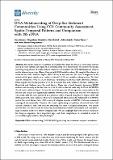Por favor, use este identificador para citar o enlazar a este item:
http://hdl.handle.net/10261/205693COMPARTIR / EXPORTAR:
 SHARE
BASE SHARE
BASE
|
|
| Visualizar otros formatos: MARC | Dublin Core | RDF | ORE | MODS | METS | DIDL | DATACITE | |

| Campo DC | Valor | Lengua/Idioma |
|---|---|---|
| dc.contributor.author | Atienza, Sara | es_ES |
| dc.contributor.author | Guardiola, Magdalena | es_ES |
| dc.contributor.author | Praebel, Kim | es_ES |
| dc.contributor.author | Antich, Adrià | es_ES |
| dc.contributor.author | Turon, Xavier | es_ES |
| dc.contributor.author | Wangensteen, Owen S. | es_ES |
| dc.date.accessioned | 2020-03-29T09:50:48Z | - |
| dc.date.available | 2020-03-29T09:50:48Z | - |
| dc.date.issued | 2020 | - |
| dc.identifier.citation | Diversity 12 : 123 (2020) | es_ES |
| dc.identifier.uri | http://hdl.handle.net/10261/205693 | - |
| dc.description | Estee artículo contiene 24 páginas, 4 tablas, 8 figuras. | es_ES |
| dc.description.abstract | Among the complex ecosystems and habitats that form the deep sea, submarine canyons and open slope systems are regarded as potential hotspots of biodiversity. We assessed the spatial and temporal patterns of biodiversity in sediment communities of a NW Mediterranean Canyon and its adjacent open slope (Blanes Canyon) with DNA metabarcoding. We sampled three layers of sediment and four different depths (900–1750 m) at two seasons, and used a fragment of the mitochondrial gene cytochrome c oxidase subunit I (COI) as a metabarcoding marker. The final dataset contained a total of 15,318 molecular operational taxonomic units (MOTUs). Metazoa, Stramenopiles and Archaeplastida were the dominant taxa and, within metazoans, Arthropoda, Nematoda and Cnidaria were the most diverse. There was a trend towards decreasing MOTU richness and diversity in the first few cm (1 to 5) of the sediment, with only 26.3% of the MOTUs shared across sediment layers. Our results show the presence of heterogeneous communities in the studied area, which was significantly different between zones, depths and seasons. We compared our results with the ones presented in a previous study, obtained using the v7 region of the 18S rRNA gene in the same samples. There were remarkable differences in the total number of MOTUs and in the most diverse taxa. COI recovered a higher number of MOTUs, but more remained unassigned taxonomically. However, the broad spatio-temporal patterns elucidated from both datasets coincided, with both markers retrieving the same ecological information. Our results showed that COI can be used to accurately characterize the studied communities and constitute a high-resolution method to detect ecological shifts. We also highlight that COI reference databases for deep-sea organisms have important gaps, and their completeness is essential in order to successfully apply metabarcoding techniques. | es_ES |
| dc.description.sponsorship | The sampling has been done in the framework of the DOSMARES project (CTM2010-21810) of the Spanish Government. This research has been funded by project PopCOmics CTM2017-88080 (MCIU/AEI/FEDER, UE) of the Spanish Government. This is a contribution from the Consolidated Research Group “Benthic Biology and Ecology” SGR2017-1120 of the Catalan Government. | es_ES |
| dc.language.iso | eng | es_ES |
| dc.publisher | Multidisciplinary Digital Publishing Institute | es_ES |
| dc.relation.isversionof | Publisher's version | es_ES |
| dc.rights | openAccess | es_ES |
| dc.subject | DNA metabarcoding | es_ES |
| dc.subject | COI | es_ES |
| dc.subject | 18S rRNA gene | es_ES |
| dc.subject | Deep Sea | es_ES |
| dc.subject | Submarine canyons | es_ES |
| dc.subject | Meiofauna | es_ES |
| dc.title | DNA Metabarcoding of Deep-Sea Sediment Communities Using COI: Community Assessment, Spatio-Temporal Patterns and Comparison with 18S rDN | es_ES |
| dc.type | artículo | es_ES |
| dc.description.peerreviewed | Peer reviewed | es_ES |
| dc.relation.publisherversion | https://doi.org/10.3390/d12040123 | es_ES |
| dc.identifier.e-issn | 1424-2818 | - |
| dc.relation.csic | Sí | es_ES |
| oprm.item.hasRevision | no ko 0 false | * |
| dc.type.coar | http://purl.org/coar/resource_type/c_6501 | es_ES |
| item.openairecristype | http://purl.org/coar/resource_type/c_18cf | - |
| item.fulltext | With Fulltext | - |
| item.cerifentitytype | Publications | - |
| item.openairetype | artículo | - |
| item.languageiso639-1 | en | - |
| item.grantfulltext | open | - |
| Aparece en las colecciones: | (CEAB) Artículos | |
Ficheros en este ítem:
| Fichero | Descripción | Tamaño | Formato | |
|---|---|---|---|---|
| Atienza et al 2020.pdf | 1,41 MB | Adobe PDF |  Visualizar/Abrir |
CORE Recommender
Page view(s)
227
checked on 16-abr-2024
Download(s)
161
checked on 16-abr-2024
Google ScholarTM
Check
NOTA: Los ítems de Digital.CSIC están protegidos por copyright, con todos los derechos reservados, a menos que se indique lo contrario.
